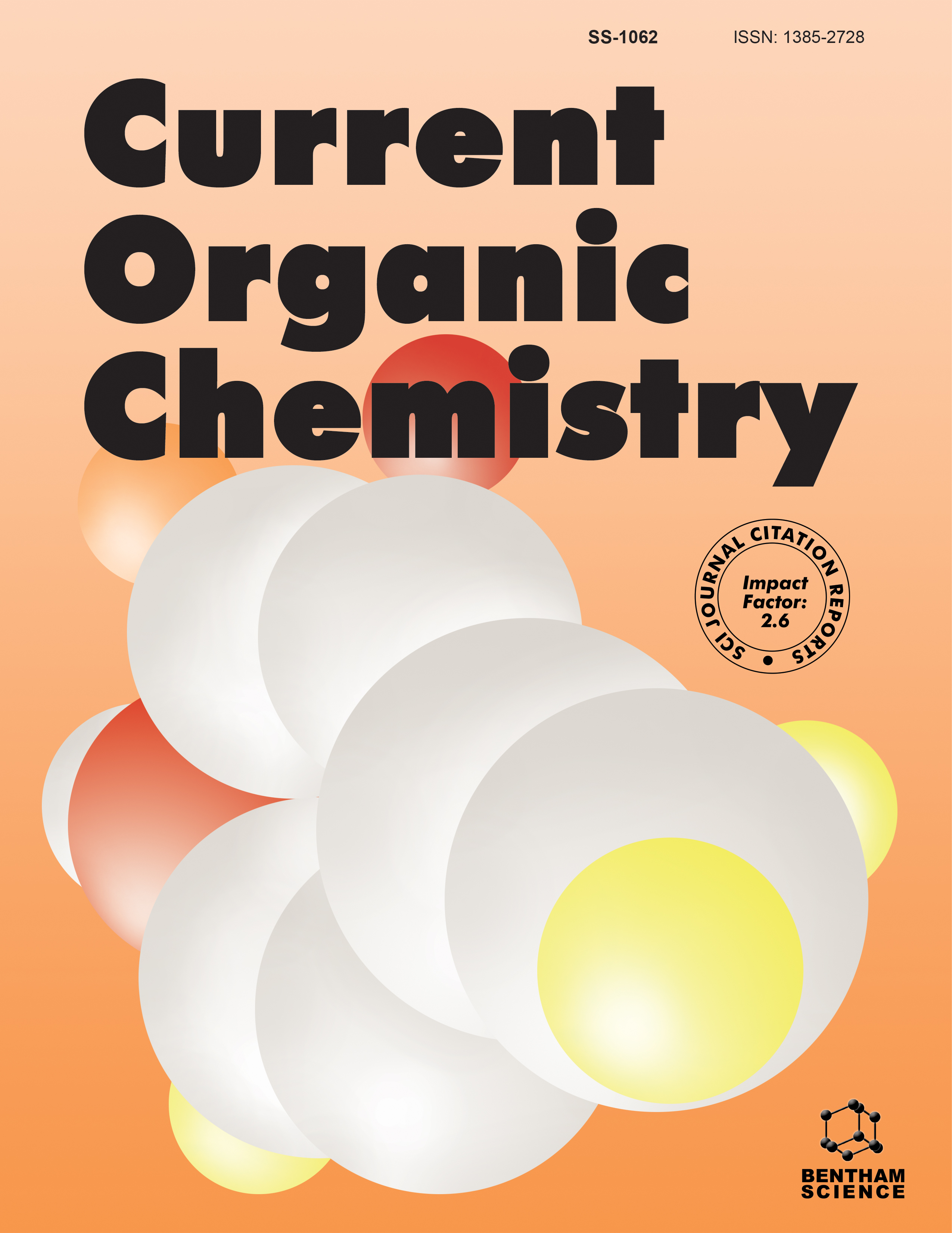- Home
- A-Z Publications
- Current Organic Chemistry
- Previous Issues
- Volume 26, Issue 11, 2022
Current Organic Chemistry - Volume 26, Issue 11, 2022
Volume 26, Issue 11, 2022
-
-
Illuminating the G-Quadruplex: A Review on Fluorescent Probes for Detecting Polymorphic G-Quartet DNA Structures
More LessAuthors: Susantha K. Ganegamage and Michael D. HeagyModulating crucial biological processes such as gene regulation, aging, and relationship to globally important human health issues such as cancer has significantly brought considerable attention to G-quadruplex over the past few decades. As the impact of Gquadruplex emerges on so many biological roles, cancer prognosis and pathogenesis have not been fully understood, and selective small molecular binders with suitable chemical, photophysical and biological properties are potentially applicable biophysical tools for tracking Gquadruplex functions. The chemical properties include suitable water solubility, liphophilicity, etc., and the photophysical properties include excitation, emission, stoke-shift, lifetime, quantum yield, and measurable, selective changes of former photophysical parameters within the ideal spectral window upon interaction with the target. The biological properties include; toxicity, cellular infiltration, and selective binding with G-quadruplex over non-specific targets (e.g., duplex DNA, RNA, non-specific biomolecules etc.) in the complex cellular matrix. The development of G-quadruplex-selective probes, therefore, continues to be an important but challenging task for molecular therapeutic, diagnostic, imaging, and sensing applications. In this review, we have classified and summarized several classes of probes; carbocyanine, porphyrins, ethidium, carbazoles, acridines, tripodal or tetrapodal probes, pyrimidine carboxamides, tianguleniums, anthraquinones, polyaromatic hydrocarbons, BODIPY dyes, berberines, acetones and their derivatives for the variation of selectivity, photophysical, and biological properties with respect to the structural modifications, which ultimately provide helpful guidance for designing novel probes with optimal characteristics.
-
-
-
Bioactive Compounds from Polar Regions: An Account of Chemical Ecology and Biotechnological Applications
More LessAuthors: Archana Singh and Keisham S. SinghOrganisms living in polar regions experience harsh environmental conditions. To cope and adapt to the extreme conditions, organisms produce specialized metabolites. Such metabolites exhibit various biological activities and thus find application in the pharmaceutical, food and cosmetic industries. Numerous secondary metabolites have been isolated from polar organisms that exhibited interesting biological properties. With ongoing climate change and the opening up of the polar regions for resource exploration, it is important to realize the natural product potential and scope of the regions. This review describes a brief account of bioactive compounds reported from polar organisms along with their ecological perspective and biotechnological applications. We present a detailed overview of the chemical structures of the compounds isolated from polar regions, which are grouped into usnic acid, MAAs, asterric acids, depsides, depsidones and psedodepsidones, alkaloids, polysaccharides and exopolysaccharides. We have also discussed the ecological significance of the compounds, covering a general aspect as well as a specific account, wherever reported, along with bioactivities. The review covers the literature reported from 2010 to 2020.
-
-
-
Applications of N-Halo Reagents in Multicomponent Reactions: A Still Underrated Approach for the Construction of Heterocyclic Scaffolds
More LessAuthors: Vitor S.C. de Andrade and Marcio C.S. de MattosHeterocyclic scaffolds are important from both academic and industrial points of view. Due to their biological and pharmacological activities, they are useful intermediates in organic synthesis and have great interest in medicinal and natural products chemistry. N-halo compounds bearing an electron-withdrawing group on nitrogen (e.g., carbonyl, sulfonyl) present the unique chemical properties of the N-X bond that give them broad synthetic utility for diverse organic transformation. In the past years, significant progress has been achieved in the synthesis of heterocyclic compounds with the intermediacy of N-halo compounds. Numerous strategies (e.g., electrophilic cyclizations, asymmetric halocyclizations, oxidative cyclizations, radical processes) were implemented featuring high atom- and step-economy, and more efficient procedures are continually being developed. An interesting approach consists of using Nhalo compounds to promote multicomponent reactions (MCRs), which rapidly became an emerging field in heterocyclic construction. MCRs are recognized for their mild conditions, high convergence, and efficiency. Thus, the present review will focus attention on the main topics and utilization of N-halo compounds (N-halosuccinimides, trihaloisocyanuric acids, N-halosulfonamides, etc.) as green and convenient reagents in heterocyclic construction via MCRs. Examples of the preparation of azoles, pyridines, 1,4-dihydropyridines, chromenes, and xanthenes, among other scaffolds are presented and discussed.
-
-
-
Synthesis of Graphene-Based Nanomaterials for Medicinal Applications: A Mini- Review
More LessAuthors: Shobhana Sharma and Anupama Singh“Graphene oxide” is obtained by the reaction of two-dimensional graphene sheets with oxygen-containing oxidants, like atomic oxygen (O), hydroxyl (OH) and carboxyl (COOH). Graphene oxide-based nanomaterials are an interesting topic in research due to the presence of distinctive physicochemical properties in them. Biocompatibility is an important factor for applications in tissue engineering. The catalytic activity of carbon-based catalysts has been deeply affected by their surface chemistry. The presence of oxygen functionality at the graphene oxide surface provides reactive sites for chemical alteration. Graphene oxide (GO), is currently being used in biotechnology and medicine for the treatment of cancer, drug delivery, and also for cellular imaging and as anti-viral agents, etc. Also, GO is characterized by various physicochemical properties, like nanoscale size, high surface area, and electrical charge. Recent studies suggest that several factors affect the biocompatibility of carbon-based nanomaterials.
-
Volumes & issues
-
Volume 29 (2025)
-
Volume 28 (2024)
-
Volume 27 (2023)
-
Volume 26 (2022)
-
Volume 25 (2021)
-
Volume 24 (2020)
-
Volume 23 (2019)
-
Volume 22 (2018)
-
Volume 21 (2017)
-
Volume 20 (2016)
-
Volume 19 (2015)
-
Volume 18 (2014)
-
Volume 17 (2013)
-
Volume 16 (2012)
-
Volume 15 (2011)
-
Volume 14 (2010)
-
Volume 13 (2009)
-
Volume 12 (2008)
-
Volume 11 (2007)
-
Volume 10 (2006)
-
Volume 9 (2005)
-
Volume 8 (2004)
-
Volume 7 (2003)
-
Volume 6 (2002)
-
Volume 5 (2001)
-
Volume 4 (2000)
Most Read This Month


